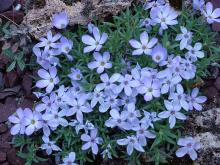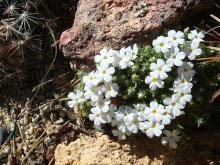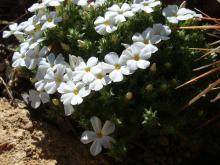Wouldn't you know I can't find a closeup (in digital format anyway), but since this poor Phlox category has been going begging, I can at least show an overall shot of an outstanding phlox of the Southern Rockies: for some reason, we find Phlox condensata very hard to grow in the open ground for more than a few years: it peters out. But in a trough it spreads and is magnificent (a phenomenon true of other alpines as well). Here in the first picture it is in a trough featuring plants of Pikes Peak at Denver Botanic Gardens. If you come to Salida you will see this phlox growing everywhere in the Mosquito Range: it is so fragrant in addition to being a dense cushion plant.
Comments
Re: One of the best phloxes: Phlox condensata
Glad you approve: the blue is Viola pedatifida, which grows at a low elevation in El Paso county, not strictly speaking on Pikes Peak (poetic license?)....the rough green along the top of the trough is none other than Clematis columbiana var. tenuiloba: this blooms a bit later than the phlox, and is stunning here as well, with deep almost violet purple flared bells...everything contrasts so nicely against that pink granite!
Re: One of the best phloxes: Phlox condensata
Could I say this trough is a nice piece of masonry? (or do I use the wrong word??)
My wife saw the picture and now she want me to change a "trough" with water plants to something similar to yours!
Re: One of the best phloxes: Phlox condensata
My Viola pedatifida is a terrible clone. Flowers hardly show since they don't go above the foliage.
How tall (or spreading) does that clematis get? I have it growing in richer soil so it grows rather rampantly. It never occurred to me that it would be a trough candidate.
Re: One of the best phloxes: Phlox condensata
It never ceases to amaze me how differently plants perform in different climates.
Viola pedatifida always blooms conspicuously, but can be rather weedy in some sites. I notice recently it's disappeared most everywhere we grew it except in that trough!
We find Clematis tenuiloba really pretty temperamental: Laporte Avenue nursery grows it like a weed in their garden, but for myself at my house and the Botanic Gardens it has only proved permanent in troughs!
The troughs were built by Mark Fusco, on our staff (now working in a Green Roof company), a remarkable man and good friend. They are monumental: some of them four or five feet long and very deep. We call them Saxon Sarcophagi. They are made with huge forms, and moved by front loader: not for just anyone...I wish I had a few myself! The markings on the side are the result of the plastic buckling used for the mold (to keep the mix from sticking to the wood). It is enhanced with chiseling by Mark: they are magnificent! You should see them in April and early May when they give us a great preview of the coming alpine summer.
Re: One of the best phloxes: Phlox condensata
Wouldn't you know I can't find a closeup (in digital format anyway), but since this poor Phlox category has been going begging, I can at least show an overall shot of an outstanding phlox of the Southern Rockies: for some reason, we find Phlox condensata very hard to grow in the open ground for more than a few years: it peters out. But in a trough it spreads and is magnificent (a phenomenon true of other alpines as well). Here in the first picture it is in a trough featuring plants of Pikes Peak at Denver Botanic Gardens. If you come to Salida you will see this phlox growing everywhere in the Mosquito Range: it is so fragrant in addition to being a dense cushion plant.
I've found the same to be true here in the northeast but the place where it seems to be succeeding beyond ll expectations is in the crevice bed. Maybe it likes its roots to be a bit constricted? It bloomed very well this year and stayed quite tight. I'd like to add two phloxes to your "best" category; Phlox pungens and Phlox kelseyi. The P. kelseyi has multiple bloom seasons here, which is quite wonderful. The secondary bloom periods are good but usually not as intense as the primary bloom time. They still make quite a show. The record was four bloom times during one lovely growing season without intense heat and humidity. Now to find the pictures
MMcD, moderator: Photo re-uploaded to indicate that it is Phlox pungens.
Re: One of the best phloxes: Phlox condensata
Spiegel
These high altitude cushion phlox are a hard group to decipher. There seems to be a lot of confusion surrounding their nomenclature.
I found this paper on line that explanes some of this confusion.
http://www.brit.org/fileadmin/Publications/JBotResInstTexas_3_2/645-658_...
I am also posting some shots of what I am led to understand is Phlox condensata ssp. covillei (syn- P. covillei)
Re: One of the best phloxes: Phlox condensata
The phlox I showed was Phlox pungens. Sorry, haven't learned to title pictures. The first person I knew in NARGS was Linc Foster (not a bad way to start!), who once said if you want to i.d. a western phlox know exactly where you are. That seems to be reasonably true
Re: One of the best phloxes: Phlox condensata
What a great form of Phlox pungens! I wish I grew it like that...must try again!
Re: One of the best phloxes: Phlox condensata
It's one of my favorites, Panayoti. I grow it in the new crevice gardens and also in troughs. The great thing is that it is one of the rebloomers. It will bloom off and on after resting up to hard frost. The one pictured is in a trough - the ones in the crevice garden are tighter in growth. Another good doer here is Phlox pulvinata. It seems to be a stayer. I find Phlox hoodii very difficult and it doesn't stick around for long, but Phlox hendersonii does and is lovely.
Re: One of the best phloxes: Phlox condensata
AMAZING: I have never had Phlox hendersonii last more than a few months, but I have Phlox hoodii in troughs for over 20 years--maybe even 25...I have never had luck with P. pungens.
It is obvious that siting and microclimate are paramount: I would NEVER have dreamed either of these would make it in New York. Such arrogance!
Can't wait to try them again: only I shall pamper them this time in the best troughs and crevices...thanks for opening my eyes!
Re: One of the best phloxes: Phlox condensata
A dinky little Phlox hendersonii (I think that's what it is - please correct me if I'm wrong!) that has, however, lasted since 2006 here in a trough. This photo is from last year at this time; this year's bloom, perhaps due to all the snow and wretched weather, was prolonged but thin at any one time... didn't seem worth photographing. Can't wait to see Anne's to see what my plant should aspire to! :)
Re: One of the best phloxes: Phlox condensata
Hi Lori, I'm so sorry that I didn't remember to photograph Phlox hendersonii this year. All my photos are slides. I'm always forgetting to photograph so it's taking a long time to replace the slide with digital images.
I'll definitely photograph it next year. Of course, we have had an incredibly hot spring, more like July weather, so it's long finished blooming. I think the foliage is quite wonderful as well. It glistens a bit - I think of it as diamond dusted. It seems to be a good doer here.
Re: One of the best phloxes: Phlox condensata
A dinky little Phlox hendersonii (I think that's what it is - please correct me if I'm wrong!) that has, however, lasted since 2006 here in a trough. This photo is from last year at this time; this year's bloom, perhaps due to all the snow and wretched weather, was prolonged but thin at any one time... didn't seem worth photographing. Can't wait to see Anne's to see what my plant should aspire to! :)
Lori, I wouldn't belittle your plant; the flowers are so round, distinctive, and satisfying, I personally would be very happy with such a "dinky little" plant. :D
Re: One of the best phloxes: Phlox condensata
Wow, Phlox pungens and P. condensata ssp. covillei are spectacular!
Hi Lori, I'm so sorry that I didn't remember to photograph Phlox hendersonii this year. I think the foliage is quite wonderful as well. It glistens a bit - I think of it as diamond dusted. It seems to be a good doer here.
No problem, Anne. Hope to see it next year, as it just sounds better and better!




Very nice! And what a spectacular trough, overall!